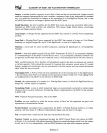
GLOSSARY OF
80287
AND FLOATING-POINT TERMINOLOGY
Integer: a
number
(positive, negative, or zero)
that
is finite
and
has
no
fractional part. Integer
can
also
mean the computer representation for such a number: a sequence of data bytes, interpreted in a
standard
way.
It
is
perfectly reasonable for Integers to be represented in a Floating-Point format; this is
what
the
80287 does whenever an
Integer
is
pushed onto the 80287 stack.
Invalid Operation: the error condition for
the
80287
that
covers all cases not covered by
other
errors.
Included
are
80287
stack
overflow and underflow,
NaN
inputs, illegal infinite inputs, out-of-range
inputs,
and
illegal unnormal inputs.
Long Integer:
an
Integer
format supported by
the
80287
that
consists of a 64-bit Two's
Complement
quantity.
Long Real: a Floating-Point
Format
supported by
the
80287
that
consists
of
a sign, an
II-bit
Biased
Exponent,
an
Implicit
Integer
Bit,
and
a 52-bit
Significand-a
total
of
64 explicit bits.
Mantissa: a
term
used for some non-Intel computers, meaning
the
Significand
of
a Floating-Point
Number.
Masked: a
term
that
applies to
each
of
the
six 80287 Exceptions I,D,Z,O,U,P. An exception is
Masked
if
a corresponding
bit
in the 80287 Control
Word
is set to
1.
If
an exception is Masked,
the
80287 will
not
generate
an
interrupt
when
the
error condition occurs;
it
will instead provide its own error recovery.
NaN: an abbreviation for
Not
a Number; a Floating-Point quantity
that
does not represent any numeric
or infinite quantity.
NaNs
should be
returned
by functions
that
encounter serious errors.
If
created
during a sequence
of
calculations, they
are
transmitted
to
the
final answer
and
can
contain information
about
where the error occurred.
Nontrapping
NaN:
a
NaN
in which
the
most significant bit of the fractional
part
of
the
Significand is
1.
By convention, these
NaNs
can
undergo
certain
operations without visible error. Nontrapping
NaNs
are implemented for
the
80287 via the software in
EH87.LIB.
Normal:
the
representation
of
a
number
in a Floating-Point format in which
the
Significandhas
an
Integer
bit I (either explicit or Implicit).
Normalizing Mode: a
state
in which nonnormal inputs
are
automatically converted to normal inputs
whenever they
are
used in arithmetic. Normalizing Mode
is
implemented for the 80287 via the software
in
EH87.LIB.
NPX:
Numeric
Processor Extension. This is the 80287.
Overflow:
an
error condition in which the
correct
answer is finite,
but
has
magnitude
too
great
to
be
represented in
the
destination format.
Packed
Decimal:
an
Integer
format
supported by the 80287. A
Packed
Decimal
number
is
a lO-byte
quantity, with nine bytes of
18
Binary Coded Decimal digits, and one byte for
the
sign.
Pop: to remove from a
stack
the last item
that
was placed on the stack.
Precision Control:
an
option, programmed
through
the
80287 Control Word,
that
allows all 80287
arithmetic to be performed with reduced precision. Because no speed advantage results from this option,
its only use
is
for strict compatibility with
the
IEEE
Standard,
and with
other
computer
systems.
Glossary-3


















